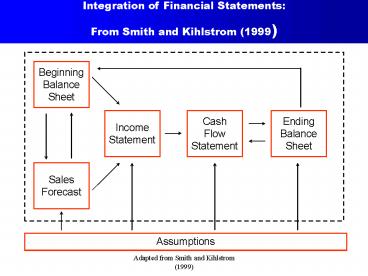Integration of Financial Statements: - PowerPoint PPT Presentation
Title:
Integration of Financial Statements:
Description:
Title: No Slide Title Last modified by: Bhagat Created Date: 6/21/1998 7:17:25 PM Document presentation format: On-screen Show Other titles: Times New Roman Arial ... – PowerPoint PPT presentation
Number of Views:42
Avg rating:3.0/5.0
Title: Integration of Financial Statements:
1
Integration of Financial Statements From Smith
and Kihlstrom (1999)
2
Four key questions to be answered in a sales
forecast
1) When will the venture begin to generate
revenues? 2) Once revenues are being generated,
how rapidly will they grow? 3) Over what span of
time (3 years, 5 years, 10 years, etc.) should
the forecast be made? 4) What is an
appropriate forecasting interval (weekly,
monthly, annually, etc.)?
3
General rules of financial forecasting
Part 1
- Build and support a schedule of assumptions
- Begin with a forecast of sales
- If the sales growth is expected to track
inflation, consider forecasting - sales in real terms
- When using historical data to forecast,
consider a weighting scheme - which focuses on the firms most recent
experiences - For new ventures, choose several yardstick
firms and compare to aid in - developing underlying assumptions
regarding expected performance - Integrate the pro forma balance sheet and
income statement variables - through formulas
4
General rules of financial forecasting
Part 2
- Consider time span. To assess financial need,
project until the firm - expects follow up financing. To determine
venture value, extrapolate - to the point of harvest
- Determine the planning horizon of the venture
to establish - forecasting intervals
- Test the models rationality by tracing line
items across financial statements - Apply sample scenarios and compare outcomes to
estimations - Try a basic sensitivity analysis to ensure the
model yields reasonable - results when magnitudes and growth rates
of key variables change
5
New company assumptions
Part I
1) Development will require 18 months, during
which no sales will be made 2) Initial sales of
10,000 in the 19th month 3) Sales will grow 8
per month in real terms for three years and at
the inflation rate thereafter 4) Cash
operating expenses during the development period
of 15,000 per month, plus
inflation 5) Inflation at 3 percent per
year 6) A 200,000 production facility will
come on line at the end of month 18. The
facility is to be leased by the company for the
first 5 years of operations with monthly
payments of 3,000 7) Gross profit of 60 of
sales revenue on materials costs with trade
discounts 8) Selling expenses of 15 of
sales. 9) Administrative expenses of 2,000 per
month beginning in month 19, growing at the
inflation rate, plus 15 percent of sales
(Included in development period operating
expense total)
6
New company assumptions
Part II
10) Entrepreneurs salary of 3,000 per month
through the first full year of sales
(included in initial operating expenses),
increasing thereafter by 500 per month 11)
Corporate tax rate of 45. No loss carry
forward 12) All sales are for credit. The
average collection period is 45 days. No
discount for prompt
payment 13) The inventory turnover rate is 5
times per year, measured against ending
inventory 14) The company desires to maintain
the greater of 30 days sales in cash or
10,000 15) All materials are purchased on
credit, with terms of 2/10 net 30. The company
anticipates paying in time
to receive the discount. The payables period is
10 days 16) The entrepreneur will borrow any
funds necessary at a rate of 1 per month 17)
Initial investment by the entrepreneur of
200,000. Additional financing by
borrowing on a line of credit
7
New company sales forecast
(Forecast generated monthly, selected months
shown)































